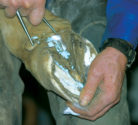Advertise Follow Us
Diseases
Double-Barreled Hoof-Care Advice
Dealing with Trimming & Shoeing Woes
Whether arguing for shorter trimming intervals or using specialty shoes, knowledge is essential
Read More
Dealing with Thrush and White Line Disease
Combining topical treatments with good hoof care will help you keep these common problems under control
Read More
Product Knowledge
Abscess Kit Makes for Easier Treatment
All-in-one package found farrier, horse-owner friendly.
Read More
Dealing With Thin-Soled Shoes
Soles get thin for a variety of reasons figuring out which one is the key to treating a case properly
Read More
One Farrier's Viewpoint
Hoof Capsule Distortion As A Process Rather Than An Event
Veteran farrier looks at hooves from a different viewpoint
Read More








